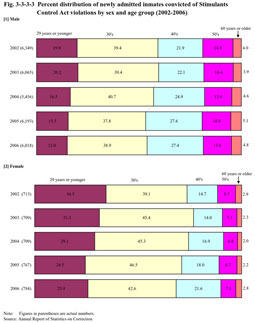| Previous Next Index Image Index Year Selection | |
|
|
3 Correction
Penal institutions have long provided educational programs for drug-abuse prevention, etc. for inmates imprisoned for drug-related offenses as guidance by treatment category. In May 2006, the Inmates Treatment Act (partly amended in 2006, and enforced as the Penal Detention Facilities Act from June 2007) was enacted, clearly specifying that special rehabilitation guidance should be provided for those with drug addiction (see Part 2, Chapter 4, Section 4, 3 (2)a).
There are 72 penal institutions which provide the guidance for withdrawing from drug dependency in special rehabilitation guidance (as of April 2007) (Source: The Correction Bureau, Ministry of Justice). Based on discussions at the “workshop on the treatment of drug-related inmates,” which consists of external intellectuals, the standard program for rehabilitation guidance for drug-related inmates was established. Recently, many institutions have strived to enhance the quality of guidance by retaining outside professionals, such as psychiatrists, pharmacists, police officials and members of private organizations working for recovery from drug addiction. Fig. 3-3-3-3 shows the percent distribution (over the last five years) of newly admitted inmates convicted of Stimulants Control Act violations, by sex and age group. The ratio of those aged 29 or younger or in their thirties is higher for females than for males. Fig. 3-3-3-3 Percent distribution of newly admitted inmates convicted of Stimulants Control Act violations by sex and age group (2002-2006) |
